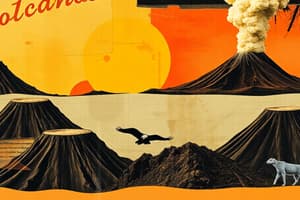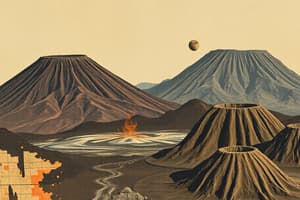Podcast
Questions and Answers
Which type of volcano is characterized by frequent eruptions and is primarily found in the Pacific Ring of Fire?
Which type of volcano is characterized by frequent eruptions and is primarily found in the Pacific Ring of Fire?
- Composite Volcano
- Extinct Volcano
- Dormant Volcano
- Active Volcano (correct)
What is a characteristic of shield volcanoes?
What is a characteristic of shield volcanoes?
- They primarily erupt basalt lava. (correct)
- They are the smallest type of volcano.
- They have a conical peak.
- They erupt with very high explosivity.
Which volcano is considered dormant and may erupt in the future?
Which volcano is considered dormant and may erupt in the future?
- Santa Maria
- Dhinodhar Hill
- Mount Kilimanjaro (correct)
- Kilauea
Which type of volcano is formed from explosive eruptions that layer ash and lava?
Which type of volcano is formed from explosive eruptions that layer ash and lava?
What is a defining feature of calderas?
What is a defining feature of calderas?
Which type of volcanic eruption is associated with highly fluid lava that can cover vast areas?
Which type of volcanic eruption is associated with highly fluid lava that can cover vast areas?
What typically happens during the eruption of a dormant volcano?
What typically happens during the eruption of a dormant volcano?
Which volcano is an example of a shield volcano?
Which volcano is an example of a shield volcano?
What is the primary cause of volcanism in astronomical bodies?
What is the primary cause of volcanism in astronomical bodies?
What distinguishes lava from magma?
What distinguishes lava from magma?
Which of the following is NOT typically formed by volcanic activity?
Which of the following is NOT typically formed by volcanic activity?
What are seismic data used for in the context of volcanic eruptions?
What are seismic data used for in the context of volcanic eruptions?
Which type of volcanic landform is typically created by explosive eruptions?
Which type of volcanic landform is typically created by explosive eruptions?
What type of volcano results in a plateau formation?
What type of volcano results in a plateau formation?
Which of the following methods helps in predicting volcanic eruptions through ground changes?
Which of the following methods helps in predicting volcanic eruptions through ground changes?
What geological feature is indicative of a natural heat source related to volcanism?
What geological feature is indicative of a natural heat source related to volcanism?
What shape do shield volcanoes typically have?
What shape do shield volcanoes typically have?
Which volcanic feature forms when the roof of a magma chamber collapses?
Which volcanic feature forms when the roof of a magma chamber collapses?
What is one of the main destructive effects of volcanic eruptions?
What is one of the main destructive effects of volcanic eruptions?
What is a characteristic of volcanic ash?
What is a characteristic of volcanic ash?
How do lava plateaus form?
How do lava plateaus form?
Which volcanic process leads to the creation of fertile soil?
Which volcanic process leads to the creation of fertile soil?
What happens during contact metamorphism?
What happens during contact metamorphism?
What can be a climate impact of volcanic eruptions?
What can be a climate impact of volcanic eruptions?
What are volcanic lakes primarily formed from?
What are volcanic lakes primarily formed from?
Which of the following factors contributes to the formation of volcanic geysers?
Which of the following factors contributes to the formation of volcanic geysers?
Which negative impact is commonly associated with volcanic activity?
Which negative impact is commonly associated with volcanic activity?
What is a significant constructive contribution of volcanic processes?
What is a significant constructive contribution of volcanic processes?
How can the hazardous effects of volcanoes be managed?
How can the hazardous effects of volcanoes be managed?
Which of the following natural phenomena can be influenced by volcanic activity?
Which of the following natural phenomena can be influenced by volcanic activity?
What can be a positive ecological impact of volcanic lakes?
What can be a positive ecological impact of volcanic lakes?
What aspect of volcanic activity should be appreciated as part of geological dynamics?
What aspect of volcanic activity should be appreciated as part of geological dynamics?
What is a key characteristic of Mid-Ocean Ridge Volcanoes?
What is a key characteristic of Mid-Ocean Ridge Volcanoes?
Where are most of the world's volcanoes primarily located?
Where are most of the world's volcanoes primarily located?
Which type of volcanic landform is characterized by dome-shaped intrusions?
Which type of volcanic landform is characterized by dome-shaped intrusions?
What type of volcanic landform is created by horizontal intrusions of magma?
What type of volcanic landform is created by horizontal intrusions of magma?
Which volcano shape is typically associated with violent eruptions and has a central vent?
Which volcano shape is typically associated with violent eruptions and has a central vent?
What distinguishes Mid-Ocean Ridges from other volcanic landforms?
What distinguishes Mid-Ocean Ridges from other volcanic landforms?
Which term describes isolated hills or mountains formed from resistant rock after erosion?
Which term describes isolated hills or mountains formed from resistant rock after erosion?
What type of volcanic landform allows lava to flow out in a continuous stream?
What type of volcanic landform allows lava to flow out in a continuous stream?
Flashcards are hidden until you start studying
Study Notes
What is Volcanism?
- Volcanism refers to the eruption of solids, liquids, gases, and their mixtures from a solid-surface astronomical body, such as Earth, moons, asteroids, and comets.
- Caused by internal heat sources, volcanism involves the partial melting of solid materials or their transformation into gas.
- Mobilized materials rise through the interior, resulting in intrusive and extrusive landforms.
What is a Volcano?
- A volcano is an opening in the Earth’s crust where gases, molten rock (lava), ash, and steam are expelled.
- Occurs in regions with relatively weak rock strata, and represents an endogenic process.
- Forms various landforms based on the eruptive nature: plateaus for non-explosive eruptions and mountains for explosive ones.
Magma vs Lava
- Magma refers to molten rock and materials residing within the Earth, often sourced from the asthenosphere.
- Lava is magma that has erupted onto the Earth's surface through a volcanic vent.
Tools and Methods to Predict Volcanic Eruptions
- Seismic Data: Monitoring earthquakes and tremors that may precede eruptions.
- Ground Deformation: Observations of ground changes indicating magma movement.
- Gas Emissions and Gravity Changes: Analyzing volcanic gas emissions and gravity/magnetic field variations.
Types of Volcanoes
- Active Volcanoes: Erupt frequently, predominantly found in the Pacific Ring of Fire (Kilauea in Hawaii, Santa Maria in Guatemala).
- Dormant Volcanoes: Have not erupted recently but may in the future (e.g., Mount Kilimanjaro in Tanzania).
- Extinct Volcanoes: No eruptions recorded in geological history (e.g., Dhinodhar Hill in Gujarat).
Types of Volcanic Eruptions
- Shield Volcanoes: Large, gentle volcanoes formed from basalt lava, typically with low explosivity (e.g., Hawaiian volcanoes).
- Composite Volcanoes: Built from cooler, thicker lava with multiple explosive eruptions (e.g., Mayon Volcano, Mount Fuji).
- Calderas: Explosive volcanoes that collapse inward during eruptions, creating depressions.
- Flood Basalt Provinces: Erupt highly fluid lava that spreads over vast areas.
- Mid-Ocean Ridge Volcanoes: Found underwater in the mid-ocean ridge system, frequently erupt due to seafloor spreading.
Distribution of Volcanoes
- Most volcanoes are located in three main belts:
- Circum-Pacific Belt (Pacific Ring of Fire)
- Mid-World Mountain Belt
- African Rift Valley Belt
Types of Volcanic Landforms
-
Intrusive Landforms: Formed when magma cools and solidifies underground.
- batholiths, sills, dikes, laccoliths, phacoliths, and monadnocks.
-
Extrusive Landforms: Created by magma that erupts and cools above the surface.
- fissure vents, conical vents, mid-ocean ridges, shield volcanoes, lava plateaus, calderas, and lava domes.
Impacts of Volcanic Eruptions
-
Destructive Effects:
- Earthquakes caused by magma movement can lead to ground cracks and destruction.
- Climate disruption from the release of gases affecting weather patterns.
- Pyroclastic flows can incinerate anything in their path.
- Volcanic ash can cause respiratory issues and health threats.
-
Constructive Effects:
- Volcanic ash enriches soils, making them highly fertile for agriculture.
- Repeated eruptions can form new landforms (e.g., islands).
- Contact metamorphism creates new valuable rocks (e.g., marble).
- Volcanic lakes and geysers contribute to unique ecosystems and freshwater sources.
Conclusion
- Volcanism represents a complex geological phenomenon with both destructive and constructive effects.
- Understanding volcanic processes is crucial for hazard management and appreciating their contributions to Earth's landscape.
Studying That Suits You
Use AI to generate personalized quizzes and flashcards to suit your learning preferences.




